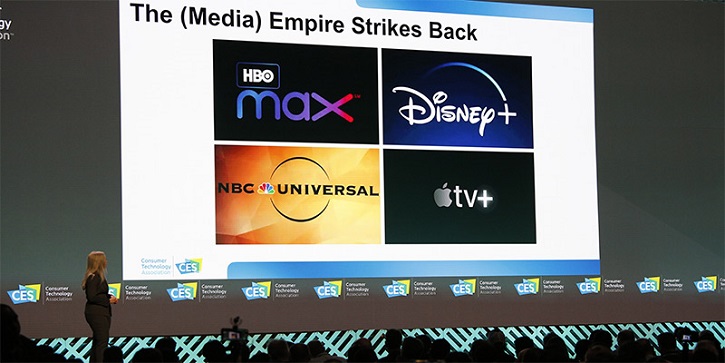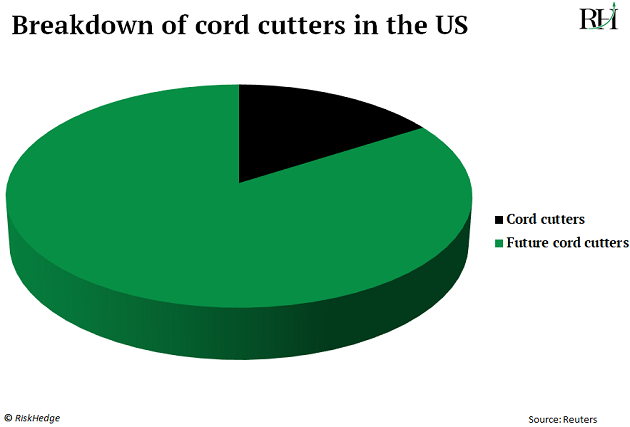
The avalanche has begun, and there’s no stopping it
- Stephen McBride
- |
- March 2, 2020
- |
- Comments
This article appears courtesy of RiskHedge.
What did you do last night?
If you’re like the vast majority of Americans, you probably watched TV.
Statistically speaking, you probably did NOT watch Netflix… Amazon Prime… Hulu, Disney+, or any other streaming service.
You watched good old-fashioned cable TV.
|
- Fact is, most Americans still haven’t “cut the cord” to quit cable...
… yet.
According to top research firm eMarketer, US cable subscriptions peaked at 100 million households in 2010.
And despite ALL that’s happened in the past decade… the rise of Netflix… the decline in cable ratings… and the media’s obsession with “cord cutters”…
Only 16 million households have “quit” cable.
In other words, 84 million American households still fork out an average of $100 bucks/month for cable!

But it won’t stay that way for long.
In fact, I wouldn’t be surprised if this circle is almost half black by the end of the year.
- Because all hell has broken loose...
You see, Americans had been cutting the cord at a slow and steady pace.
Everything changed last year. Bloomberg reports an “avalanche” of Americans quit cable in 2019. A record 5.5 million households cut the cord—a 70% jump from 2018.
And that’s just the beginning…
America’s largest cable provider, AT&T (T), hemorrhaged four million subscribers. Last month, Comcast warned that cord cutting will “speed up in 2020”…
- Meanwhile, streaming is hotter than ever…
Last year, the US had:
- 62.3 million Netflix subscribers
- 25.5 million Hulu subscribers
- 53.9 million Amazon Prime Video subscribers
- 10.9 million HBO Now subscribers
- 28.6 million subscribers to other streaming services.
That’s 181.2 million subscriptions. And Statista expects 100 million more Americans to subscribe to streaming services by 2024.
That’s 281 million people... out of 327 million total Americans. In other words, very soon, practically every American adult will subscribe to at least one streaming service.
- Apple, Amazon, and Google—three of the richest companies in history—are pouring their vast fortunes into streaming…
Apple’s poured over $6 billion into its streaming arm, Apple +.
Amazon’s invested $7 billion into its Prime Video streaming service.
And Google, which owns YouTube, collects over $15 billion a year on streaming.
There are a number of reasons why cord cutting has hit an inflection point.
The average streaming service costs $10 a month, compared to $100 for cable. Many folks are fed up with paying for 495 cable channels they don’t watch just to get the five they do.
And live sporting events, the last stronghold of cable, are moving over to streaming. Last weekend’s much-hyped Fury-Wilder boxing match streamed over ESPN’s streaming service, ESPN+.
But perhaps the most important reason of all is also the simplest...
- For the first time ever, the best shows aren’t on cable.
They’re produced by streaming services now.
Think about the shows and movies folks talk about today.
The Irishman… Making a Murderer… Stranger Things… The Crown… are all on Netflix.
The Handmaid’s Tale is produced by Hulu.
And The Mandalorian—the most in-demand TV show in the world, according to Parrot Analytics—is on Disney’s (DIS) new streaming service.
The most-watched show on cable last year was The Big Bang Theory. An average of 17 million viewers tuned in to watch it.
But over 26 million folks watched the season premiere of Netflix’s Stranger Things 3 on release day.
Companies that make hit TV shows are shifting toward streaming, too. HBO produced several “hall of famers” like The Wire… Soprano’s… and Game of Thrones. And its streaming app goes live this May.
But remember…
Despite all of this…
The majority of America’s eyeballs are still with cable TV... for now.
- Most importantly, the BIG money is still in “old guard” cable.
Think back to the chart I showed above.
As you surely know, Netflix has already handed early investors 30,000% gains.
But don’t make the mistake of thinking you’ve “missed the boat.”
Netflix is merely the first of many red-hot streaming stocks we’ll see over the next year or two.
The huge sums of money at stake practically guarantee it.
Cable companies still rake in roughly $170 billion/year.
And the five biggest cable stocks are worth over $600 billion.
That’s almost the equivalent of four NETFLIXES!
This giant heap of money is all up for grabs.
As cord-cutting turns into a full-blown avalanche, those billions will be released into the stock market.
Now’s the time to make the biggest streaming profits as cable TV gets wiped out for good.
I’ll be talking a lot more about this disruptive megatrend over the next few weeks, including how to play it for the biggest gains.
Watch your inbox.
Stephen McBride
Editor — Disruption Investor
Stephen McBride is editor of the popular investment advisory Disruption Investor. Stephen and his team hunt for disruptive stocks that are changing the world and making investors wealthy in the process. Go here to discover Stephen’s top “disruptor” stock pick and to try a risk-free subscription.
|

This article appears courtesy of RH Research LLC. RiskHedge publishes investment research and is independent of Mauldin Economics. Mauldin Economics may earn an affiliate commission from purchases you make at RiskHedge.com
